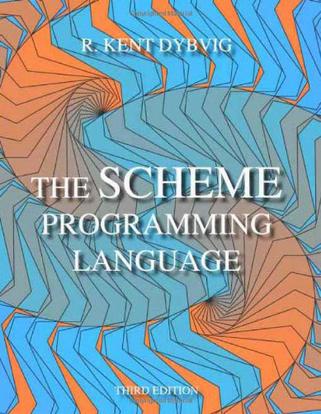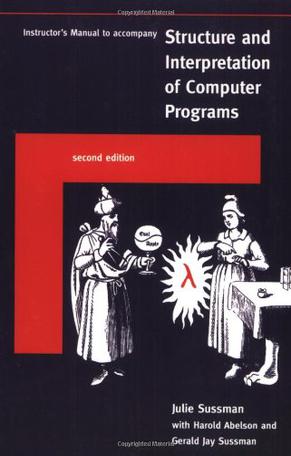-

The Scheme Programming Language
This thoroughly updated edition of The Scheme Programming Language provides an introduction to Scheme and a definitive reference for standard Scheme, presented in a clear and concise manner. Written for professionals and students with some prior programming experience, it begins by leading the programmer gently through the basics of Scheme and continues with an introduction to some of the more advanced features of the language. Many exercises are presented to help reinforce the lessons learned, and answers to the exercises are given in a new appendix. Most of the remaining chapters are dedicated to the reference material, which describes in detail the standard features of Scheme included in the Revised Report on Scheme and the ANSI/IEEE standard for Scheme. Numerous examples are presented throughout the introductory and reference portions of the text, and a unique set of extended example programs and applications, with additional exercises, are presented in the final chapter. Reinforcing the book's utility as a reference text are appendixes that present the formal syntax of Scheme, a summary of standard forms and procedures, and a bibliography of Scheme resources. The Scheme Programming Language stands alone as an introduction to and essential reference for Scheme programmers. It is also useful as a supplementary text for any course that uses Scheme. The Scheme Programming Language is illustrated by artist Jean-Pierre Hebert, who writes Scheme programs to extend his ability to create sophisticated works of digital art. -

The Scheme Programming Language
This thoroughly updated edition of The Scheme Programming Language provides an introduction to Scheme and a definitive reference for standard Scheme, presented in a clear and concise manner. Written for professionals and students with some prior programming experience, it begins by leading the programmer gently through the basics of Scheme and continues with an introduction to some of the more advanced features of the language. Many exercises are presented to help reinforce the lessons learned, and answers to the exercises are given in a new appendix. Most of the remaining chapters are dedicated to the reference material, which describes in detail the standard features of Scheme included in the Revised Report on Scheme and the ANSI/IEEE standard for Scheme. Numerous examples are presented throughout the introductory and reference portions of the text, and a unique set of extended example programs and applications, with additional exercises, are presented in the final chapter. Reinforcing the book's utility as a reference text are appendixes that present the formal syntax of Scheme, a summary of standard forms and procedures, and a bibliography of Scheme resources. The Scheme Programming Language stands alone as an introduction to and essential reference for Scheme programmers. It is also useful as a supplementary text for any course that uses Scheme. The Scheme Programming Language is illustrated by artist Jean-Pierre Hebert, who writes Scheme programs to extend his ability to create sophisticated works of digital art. -

程序设计方法(中文版)
《程序设计方法》以Scheme语言为基础介绍计算和程序设计的一般理论和实践。《程序设计方法》由8个部分和7个独立的章节(第8、13、18、24、29、33、38章)组成。8个部分主要讨论程序设计,独立章节则介绍一些与程序设计和计算相关的话题。《程序设计方法》第1至第3部分介绍了基于数据驱动的程序设计基础。第4部分介绍了程序设计中的抽象问题。第5部分和第6部分是与递归及累积相关的内容。《程序设计方法》的最后两部分说明了设计程序的意义,阐述了如何应用前6个部分所描述的程序设计诀窍,以及使用赋值语句必须特别小心的一些问题。 《程序设计方法》可作为高等院校计算机科学与技术专业“程序设计导论”和“计算导论”的教材和教学参考书,也可作为函数式语言和Scheme语言的入门教材。 -

Instructor's Manual t/a Structure and Interpretation of Computer Programs
This instructor's manual and reader's guide accompanies the second edition of Structure and Interpretation of Computer Programs, by Harold Abelson and Gerald Jay Sussman with Julie Sussman. It contains discussions of exercises and other material in the text as well as supplementary material, additional examples and exercises, and teaching suggestions. An appendix summarizes the Scheme programming language as used in the text, showing at what point in the text each element of Scheme is introduced. -

The Seasoned Schemer
drawings by Duane Bibbyforeword and afterword by Guy L. Steele Jr.The notion that "thinking about computing is one of the most exciting things the human mind can do" sets both The Little Schemer (formerly known as The Little LISPer) and its new companion volume, The Seasoned Schemer, apart from other books on LISP. The authors' enthusiasm for their subject is compelling as they present abstract concepts in a humorous and easy-to-grasp fashion. Together, these books will open new doors of thought to anyone who wants to find out what computing is really about. The Little Schemer introduces computing as an extension of arithmetic and algebra;things that everyone studies in grade school and high school. It introduces programs as recursive functions and briefly discusses the limits of what computers can do. The authors use the programming language Scheme, and interesting foods to illustrate these abstract ideas. The Seasoned Schemer informs the reader about additional dimensions of computing: functions as values, change of state, and exceptional cases. The Little LISPer has been a popular introduction to LISP for many years. It had appeared in French and Japanese. The Little Schemer and The SeasonedSchemer are worthy successors and will prove equally popular as textbooks for Scheme courses as well as companion texts for any complete introductory course in Computer Science. -

Structure and Interpretation of Classical Mechanics
This textbook takes an innovative approach to the teaching of classical mechanics, emphasizing the development of general but practical intellectual tools to support the analysis of nonlinear Hamiltonian systems. The development is organized around a progressively more sophisticated analysis of particular natural systems and weaves examples throughout the presentation. Explorations of phenomena such as transitions to chaos, nonlinear resonances, and resonance overlap to help the student to develop appropriate analytic tools for understanding. Computational algorithms communicate methods used in the analysis of dynamical phenomena. Expressing the methods of mechanics in a computer language forces them to be unambiguous and computationally effective. Once formalized as a procedure, a mathematical idea also becomes a tool that can be used directly to compute results.The student actively explores the motion of systems through computer simulation and experiment. This active exploration is extended to the mathematics. The requirement that the computer be able to interpret any expression provides strict and immediate feedback as to whether an expression is correctly formulated. The interaction with the computer uncovers and corrects many deficiencies in understanding.